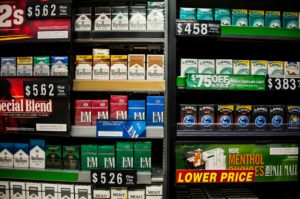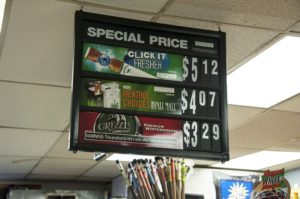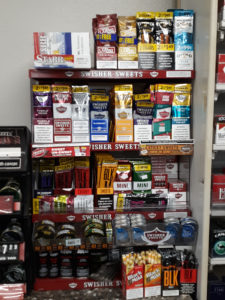Welcome to CounterTobacco.org’s “News and Research Roundup!” Each month we post a summary of the latest research, reports, and news stories on counteracting tobacco product sales and marketing at the point of sale (POS). Keeping up with what’s happening in the POS movement all across the country can help you choose policies and strategies that work best for your community. New research can help provide support for your work and evidence for the importance of the “War in the Store.” Have a story you don’t want us to miss? E-mail it to us!
New Research
Menthol and Other Flavored Tobacco Products
- Banning menthol cigarettes: A social justice issue long overdue, Nicotine & Tobacco Research

- This editorial details the increase in menthol cigarette use after the passing of the 2009 Family Smoking Prevention and Tobacco Control Act, which banned sales of flavored cigarettes other than menthol. The authors call out the federal lack of urgency and inaction in implementing a menthol cigarette ban despite the wealth of independent research, as well as an FDA-led report documenting the harms and dangers of menthol cigarettes, especially among Black individuals who smoke, and the major public health benefits a ban on menthol cigarettes would have. As menthol cigarettes are and have been more heavily marketed and targeted towards Black individuals and communities, this inaction qualifies not only as a public health issue but as a social justice one as well. The authors highlight the “monumental implications for both the short- and long-term physical and mental health of communities of color” a menthol cigarette ban could have. They implore policy makers and others in tobacco control to ban menthol in the name of health equity and social justice. Learn more about menthol and restrictions on product availability.
- News story: Would menthol cigarettes be banned if the typical consumer was young, white, and upper-middle class?, EurekAlert!
- Menthol e-cigarette sales rise following 2020 FDA guidance, Tobacco Control
- In 2019, Juul voluntarily removed their mint-flavored cartridges from the market, and in the beginning of 2020, the FDA released a guidance banning the sale of flavored cartridges other than those of tobacco or menthol flavoring. Following both of these actions, total e-cigarette sales declined; however, menthol flavored e-cigarette sales increased. In the 4 weeks after Juul removed their mint pods, researchers noticed a 59.4% increase in the market share of menthol-flavored e-cigarettes. In the 4 weeks after the FDA guidelines were released, they noticed a 54.5% increase in the market share of menthol e-cigarettes, which surged to an 82.8% increase at 8 weeks post-release. The findings depict a major sway from mint and other flavors towards menthol-flavored e-cigarettes and highlight the importance of including menthol products in a flavor ban. Learn more about menthol and restrictions on product availability.
- Identifying best practices in adoption, implementation and enforcement of flavored tobacco product restrictions and bans: Lessons from experts, Tobacco Control
- This comprehensive article highlights findings from in-depth interviews conducted in 2019 with 17 individuals with expertise in flavored tobacco product policies. The article breaks down findings into four overarching themes – (1) program planning and legislative preparations, (2) education and community outreach, (3) implementation and enforcement and (4) policy impact. Flavor bans have been successful in limiting sales of tobacco products and have withstood legal industry opposition, so this insight into lessons learned and best practices will be helpful in informing successful ongoing and future policy efforts. Learn more about flavored tobacco products and restrictions on product availability.
- Evaluating the effect of switching to non-menthol cigarettes among current menthol smokers: An empirical study of a potential ban on characterizing menthol flavour in cigarettes, Tobacco Control
- To simulate the effects of a potential ban on menthol cigarettes, researchers had 29 non-treatment-seeking adults who smoked menthol cigarettes switch to a matched-brand non-menthol cigarette for 2 weeks. During these 2 weeks, participants smoked
 an average of 2.2 fewer cigarettes per day, had significantly lower nicotine dependence scores, and expressed greater quitting motivation and confidence. As well, Black participants, compared to non-Black participants, saw a greater reduction in cigarettes smoked per day (mean decrease = 3.5 cigarettes) during this timeframe. The researchers suggest that these findings indicate that a ban on menthol cigarettes could lead to significant reductions in smoking. Learn more about menthol and restrictions on product availability.
an average of 2.2 fewer cigarettes per day, had significantly lower nicotine dependence scores, and expressed greater quitting motivation and confidence. As well, Black participants, compared to non-Black participants, saw a greater reduction in cigarettes smoked per day (mean decrease = 3.5 cigarettes) during this timeframe. The researchers suggest that these findings indicate that a ban on menthol cigarettes could lead to significant reductions in smoking. Learn more about menthol and restrictions on product availability.
- To simulate the effects of a potential ban on menthol cigarettes, researchers had 29 non-treatment-seeking adults who smoked menthol cigarettes switch to a matched-brand non-menthol cigarette for 2 weeks. During these 2 weeks, participants smoked
POS Advertising, Marketing & Promotions
- Demographic and psychosocial moderators of the relationship between neighborhood cigarette advertising and current smoking in New York City, Health & Place
- This study on the relationship between tobacco advertising prevalence, current smoking, demographics, and psychological characteristics found that exposure to point-of-sale cigarette advertisements was associated with current cigarette smoking in New York City residents reporting depression. Participants with depression who lived in neighborhoods with the greatest number of cigarette advertisements had 1.72 times the odds of current smoking, compared to participants with depression living in areas with the lowest number of advertisements. These findings suggest that cigarette advertisements at the point of sale may act as an “environmental cue” to smoke in New York city adults with depression. Learn more about restrictions on tobacco advertising at the point of sale.
- Convenience store access and e-cigarette advertising exposure is associated with future e-cigarette initiation among tobacco-naïve youth in the PATH study (2013-2016), Journal of Adolescent Health
- Using data from waves 1-3 of the nationally representative longitudinal PATH study,
 researchers examined associations between point-of-sale exposure, e-cigarette susceptibility, and e-cigarette initiation in tobacco-naïve youth (ages 12 to 17). Compared to youth who never visited a convenience store, youth who visited a convenience store weekly had 1.51 times the odds of e-cigarette susceptibility (collected at wave 2) and 1.79 times the odds of e-cigarette initiation (collected at wave 3). Youth who noticed an e-cigarette ad at the point of sale had 1.36 times the odds of e-cigarette susceptibility compared to youth who did not notice an ad, though no significant difference was found in initiation between these two groups. Youth who reported a favorite branded e-cigarette ad had 1.31 times the odds of e-cigarette susceptibility and 1.60 times the odds of e-cigarette initiation compared to youth who did not report a favorite ad. These findings show the impact point-of-sale exposure and e-cigarette advertisements have on e-cigarette susceptibility and initiation over a 2 year period in tobacco-naïve youth. Learn more about restrictions on tobacco advertising at the point of sale.
researchers examined associations between point-of-sale exposure, e-cigarette susceptibility, and e-cigarette initiation in tobacco-naïve youth (ages 12 to 17). Compared to youth who never visited a convenience store, youth who visited a convenience store weekly had 1.51 times the odds of e-cigarette susceptibility (collected at wave 2) and 1.79 times the odds of e-cigarette initiation (collected at wave 3). Youth who noticed an e-cigarette ad at the point of sale had 1.36 times the odds of e-cigarette susceptibility compared to youth who did not notice an ad, though no significant difference was found in initiation between these two groups. Youth who reported a favorite branded e-cigarette ad had 1.31 times the odds of e-cigarette susceptibility and 1.60 times the odds of e-cigarette initiation compared to youth who did not report a favorite ad. These findings show the impact point-of-sale exposure and e-cigarette advertisements have on e-cigarette susceptibility and initiation over a 2 year period in tobacco-naïve youth. Learn more about restrictions on tobacco advertising at the point of sale.
- Using data from waves 1-3 of the nationally representative longitudinal PATH study,
Disparities
- Gender differences in reasons for using electronic cigarettes and product characteristics: Findings from the 2018 ITC Four Country Smoking and Vaping Survey, Nicotine & Tobacco Research
- This study assessed differences in e-cigarette use and reasons for use among males and females, using data from the ITC Four County Smoking and Vaping Survey (Canada, United States, England, Australia). The sample, which included nearly 4,000 adults who used e-cigarettes at least weekly, was 54% male and 46% female. The most commonly reported reason for vaping amongst females was ‘less harmful to others’, while the most commonly reported reason amongst males was ‘less harmful than cigarettes.’ Females were less likely to report using high nicotine e-liquids and high capacity tank devices than males. No significant differences in use of flavored e-liquids existed between the genders; for both males and females, fruit was reported as the most common e-liquid flavor. Learn more about e-cigarettes at the point of sale and disparities in tobacco at the point of sale.
- Retail violations of sales to minors on e-cigarettes and cigars, Public Health
- In this study, researchers analyzed national FDA compliance check data from August
 2016 to May 2018. During this time, there were over 35,000 retail violations of sales to minors. The largest proportion of these letters were for sales of cigars (40.4%), followed by cigarettes (35.6%), e-cigarettes (20.0%), and smokeless tobacco (4.0%). Underage sales violations for flavored tobacco products were rampant. Zip codes with larger populations of youth (ages 10-17) had higher odds of e-cigarette underage sales violations; neighborhoods with a larger proportion of Black and African American residents had higher odds of cigar underage sales violations, but lower odds of e-cigarette sales violations. Learn more about industry targeting of youth and point-of-sale policy solutions.
2016 to May 2018. During this time, there were over 35,000 retail violations of sales to minors. The largest proportion of these letters were for sales of cigars (40.4%), followed by cigarettes (35.6%), e-cigarettes (20.0%), and smokeless tobacco (4.0%). Underage sales violations for flavored tobacco products were rampant. Zip codes with larger populations of youth (ages 10-17) had higher odds of e-cigarette underage sales violations; neighborhoods with a larger proportion of Black and African American residents had higher odds of cigar underage sales violations, but lower odds of e-cigarette sales violations. Learn more about industry targeting of youth and point-of-sale policy solutions.
- In this study, researchers analyzed national FDA compliance check data from August
E-Cigarettes/Vape Shops
- Trends in e-cigarette use by age group and combustible cigarette smoking histories, U.S. adults, 2014-2018, American Journal of Preventative Medicine
- Researchers analyzed data collected from over 150,000 American adults in cross-
 sectional, nationally representative National Health Interview Surveys between 2014 and 2018 to determine trends in e-cigarette prevalence across age groups and cigarette smoking histories. For younger adults (ages 18-29), e-cigarette use increased across all smoking history groups – current, recent quitters (<1 year), near-term quitters (1-8 years), long-term quitters (>8), and never smokers. For younger adults, the biggest increases were in never smokers, with e-cigarette prevalence jumping from 1.3% to 3.3% from 2014 to 2018, and near-term quitters, with prevalence increasing from 9.1% to 19.2%. For middle-aged (30-49 years old) and older adults (ages 50+), the only significant increase in e-cigarette use was in near-term quitters. Overall, the largest absolute population increase in e-cigarette use during this timeframe was among young-adult never smokers, highlighting a rise in initiation of nicotine products with e-cigarettes. Learn more about e-cigarettes at the point of sale.
sectional, nationally representative National Health Interview Surveys between 2014 and 2018 to determine trends in e-cigarette prevalence across age groups and cigarette smoking histories. For younger adults (ages 18-29), e-cigarette use increased across all smoking history groups – current, recent quitters (<1 year), near-term quitters (1-8 years), long-term quitters (>8), and never smokers. For younger adults, the biggest increases were in never smokers, with e-cigarette prevalence jumping from 1.3% to 3.3% from 2014 to 2018, and near-term quitters, with prevalence increasing from 9.1% to 19.2%. For middle-aged (30-49 years old) and older adults (ages 50+), the only significant increase in e-cigarette use was in near-term quitters. Overall, the largest absolute population increase in e-cigarette use during this timeframe was among young-adult never smokers, highlighting a rise in initiation of nicotine products with e-cigarettes. Learn more about e-cigarettes at the point of sale. - News story: New study finds largest population increase among U.S adult electronic cigarette users in younger adults that have never smoked combustible cigarettes, cancer.org
- Researchers analyzed data collected from over 150,000 American adults in cross-
- Electronic cigarettes for smoking cessation, Cochrane Database of Systematic Reviews
- An update to a Cochrane review first published in 2014, this article adds 35 new studies on the effect and safety of electronic cigarettes [ECs] as smoking cessation devices. The review finds “moderate-certainty evidence that ECs with nicotine increase quit rates compared to ECs without nicotine and compared to NRT.” However, the authors also note that “evidence comparing nicotine EC with usual care/no treatment also suggests benefit, but is less certain.” The authors describe limitations to their conclusions, including limited long-term follow-up in the included studies and few randomized control trials. Learn more about e-cigarettes at the point of sale.
- News story: Updated Cochrane Review shows electronic cigarettes can help people quit smoking, EurekAlert!
International
- ‘The last line of marketing’: Covert tobacco marketing tactics as revealed by former tobacco industry employees, Global Public Health
- Through interviews with key informants who were previously employed by tobacco companies operating in Australia, researchers uncovered various covert techniques used by tobacco companies to exploit loopholes in Australian tobacco control laws and undermine restrictions on tobacco marketing and promotion. Industry techniques generally fell under three categories – financial incentives (e.g. rebates, cash payments to retailers), experiential incentives (e.g. all-expense paid trips and events), and targeted brand education to retailers (essentially covertly turning them into brand ambassadors). The interviews show how the tobacco industry’s point-of-sale agenda can still be pushed, despite having stringent point-of-sale tobacco control regulations in place. Learn more about the war in the store.
- News story: Covert tobacco industry marketing tactics exposed by former employees, The University of Sydney
Other
- An argument for phasing out sales of cigarettes, Tobacco Control
- This article provides reasoning and strategies for achieving the ‘endgame’, or the phasing out of cigarette sales. Beyond supplying evidence of the benefits of this goal, the authors also discuss potential challenges such as industry and public opposition. Learn more about endgame strategies.
COVID-19
- The effect of smoking on COVID-19 symptom severity: Systematic review and meta-analysis, Pulmonary Medicine
- The role of smoking and nicotine in the transmission and pathogenesis of COVID-19, The Journal of Pharmacology and Experimental Therapeutics
Reports
- The price is not right, Truth Initiative

- This report details widespread support for policy efforts to raise tobacco prices. In their new nationally representative survey of 2,748 US adults, Truth Initiative discovered that 62% of participating adults supported a standard minimum price requirement for cigarette packs and a majority supported policies that prevent stores from accepting coupons (59%) and from offering multi-pack discounts (59%) – two promotional strategies heavily used by the industry to offset excise taxes and cut costs for consumers. Learn more about non-tax policy approaches to increase tobacco prices.
Industry News
- Tobacco companies challenge California flavor ban, Tobacco Reporter
- IQOS U.S. rollout hampered by COVID-19, CSP Daily News
- 2020 legislative activity in the States, CSP Daily News
POS Policy in the Media
Tobacco 21
- [NE] North Platte City Council passes new tobacco ordinance raising purchase age, addressing alternative products, North Platte Post
- [OK] Guthrie City Council votes in favor of new tobacco ordinance, New9
Menthol and Other Flavored Tobacco Products
- [CA] Mill Valley bans sale of flavored tobacco, Marin Independent Journal
- [Santa Clarita, CA] City Council extends ban on new flavored-tobacco products, The Santa Clarita Valley Signal
- Lawsuit aims to ban menthols, Big Tobacco’s bait for Black smokers, Bloomberg
- Big Tobacco goes big in effort to quash law banning sales of flavored tobacco products, San Francisco Chronicle
Health Warnings and Labels
Other
- Campaign to overturn California’s flavored tobacco sales ban accused of misleading voters, Los Angeles Times
Find more stories in last month’s News and Research Roundup.
Know of a story that we missed? Email us, and we’ll be sure to include it in next month’s roundup!


